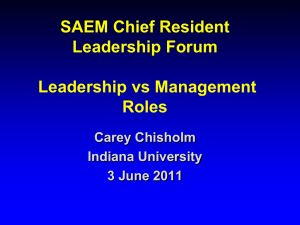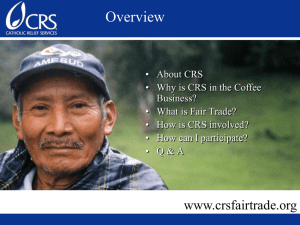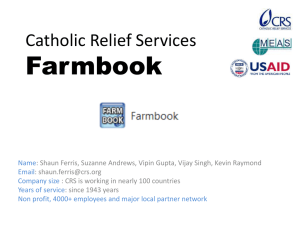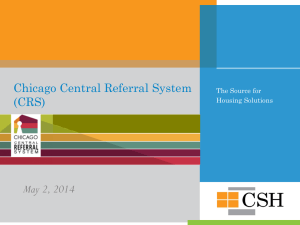Palasits-CRS-Talent Mapping Update Guidance_LINGOS General
advertisement
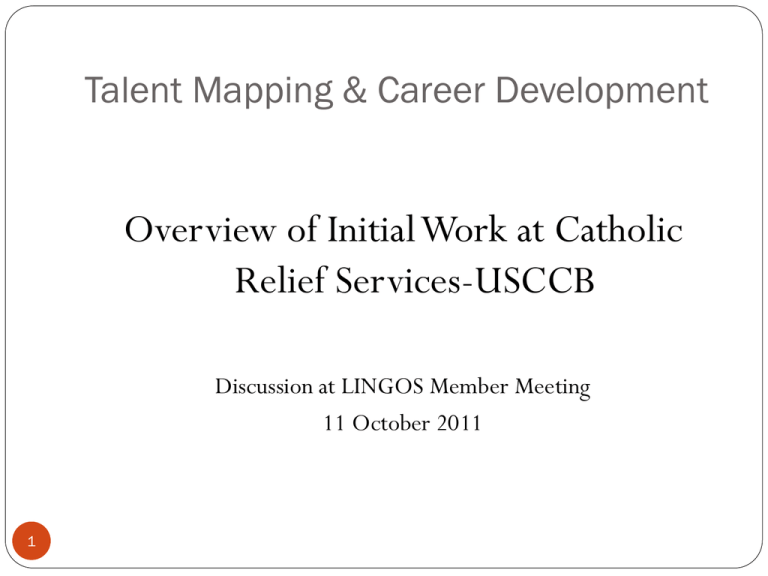
Talent Mapping & Career Development Overview of Initial Work at Catholic Relief Services-USCCB Discussion at LINGOS Member Meeting 11 October 2011 1 Pillars of Talent Management Commitment to Talent Management Competency Framework Performance Management System Information System Action Orientation 2 Competency Framework Agency-Wide Competencies Functional Competencies Agency-Wide Program Manager Management Quality Coordinator Head of Programs Country Representative Regional Director Leadership Emergency Response 3 Major Gift Officers Performance Management Performance Planning Development Planning Coaching Assessment 4 Information System Learning Performance Plans, Dev Plans, Assessment Career Profile My Team 5 Learning Recommended Curricula Mentoring Temporary Duty Assignments “Acting” Posts What is new in one’s current role 6 Why Talent Mapping? “Big picture” view of performance and learning potential of staff. Connect CRS team members with the right development opportunities to reach their full potential; Facilitate strategic succession planning for critical positions across the Agency; Harmonize individual career goals with broader Agency needs. 7 Talent Mapping—CRS Template Highly effective P E R F O R M A N C E “Solid Professional Plus” Key Performer Plus” “ “ “ Solid Pro” “Low Performer” Key Performer Inconsistent Performer” “ “Consistent Star” “Rising Star” “New in Role” Less than effective Less learning agility POTENTIAL More learning 8 agility Talent Mapping Done regularly (every six months or so) Not labelling Worthwhile if leads to action 9 The Promise of Talent Mapping: What’s in it for me (and my team)? By following a fair, consistent and routine process of examining talent, CRS will: 1. Promote confidence that CRS does invest time, resources, and energy in the career development of every team member by exploring our potential for professional growth, highlighting our achievements, and systematically exploring ways to match our abilities with increasingly demanding responsibilities. 2. 10 Take a “big picture” look at the Agency talent pool on a recurring basis to proactively, transparently, and efficiently fill vacancies with internal applicants based on their ability, interest, and availability. Talent Mapping and Succession Planning: Country Representatives Key position of Country Representative Country Representative Competencies Ready Now, Ready 1-2 years, Potential CRs Dialogue and follow-up with Country Representatives Organizational Dynamics-Trusting HR 11 Career Development: Other Actions Basic information on careers in CRS Career options Career lattices Interviews with staff Videos Helping Supervisors Discuss Career Development Careers in a Flat Organization, yet dynamic organization 12 Talent Mapping CRS Template Core Performers Highly effective P E R F O R M A N C E Less than effective “Hi-Pro” “Solid Professional Plus” Consistently produces exceptional results Consistently produces and high performance ratings. exceptional results and Knows high current job extremely performance ratings.well. Knows May not effectively job extremely adapt well. to May new not situations. adapt to new effectively requirements of the job. “Hi Pro “Key Performer Plus” Plus” Consistentlyproduces Consistently produces exceptional results exceptional results and and high high performance ratings. performance ratings. Knows Knows the job the jobwell welland and continuously enhances skills.enhances continuously Adapts to new situations skills. Adapts if necessary. to new requirements of the job. “Key Performer” “Solid Pro” Consistentlymeets Consistently meets and exceeds expectations. expectations. KnowsKnows job current well. May job not well.effectively May not effectively adapt to new adapt requirements to new situations. of the job. “Low Performer” Not delivering Not delivering onon results results as as expected. Does expected. Doesnot notadapt adapt toto change wellnature changing and may of the be a job blocked personal learner. requirements. Less learning agility Consistentlymeets Consistently meets expectations. Knows current job expectations. Knows well and job well enhances and enhances skills as skills appropriate. as Can adapt to new appropriate. Cansituations adapt toas new necessary. requirements of the job as necessary. “Inconsistent Performer” Deliversresults Delivers results inconsistently. Knows the job, and inconsistently. Knows may be the a passive job, andlearner. may beMay a passive adapt to new situations learner. May if adapt necessary. to new requirements of the job if necessary. POTENTIAL “Consistent “ConsistentStar Star” ” Outstanding, Outstanding, clearest clearestexample example ofofsuperior superior performance performanceand and potential. potential. Has Has the theability abilitytoto take takeon on major major stretch stretch assignments assignments in in new newareas. areas.Will Will challenge challenge the organization the organization to toprovide provide growth growth opportunities opportunities fast enough. fast enough. “Future Star” “Rising Star” Consistentlymeets Consistently meets and exceeds expectations. Knows expectations. Knows thethe job job well and enhances well and enhances skills as skills as appropriate. Has appropriate. Has the the ability ability to take to take on new on new and different and different challenges on challenges ona a consistent consistent basis. basis. The Pipeline “Diamond “New in Role” in the Rough” Delivers Showing results gooderratically. potential Has not yet demonstrated in role long potential enough butmake to is not careful living up to it. assessment More learning agility 13 Guidelines for Use of the 3 X 3 Talent Mapping Tool It is essential that staff be placed into a category that corresponds to their actual performance over time and their realistic potential. It is not “better” to be a Consistent Star than it is to be a Solid Professional Plus: both are performing at a high level, both are valuable to the Agency, and both will have opportunities for professional development and promotion within the Agency. Similarly, a Rising Star is not “better” than a New In Role: they have just had more time to demonstrate their ability, and may be more comfortable with the responsibilities of their current role It may be helpful to review an individual’s performance and potential separately at first to give an initial idea of grid placement, and subsequently use the grid definitions on the next page to refine this positioning as necessary. It is anticipated that a significant number of our people will fall into the ‘Key Performer’ category, and many will fall into the ‘Solid Professional Plus’. In a position based organization, it is critical to have the stability, expertise and steady, reliable performance of these employees to run the business. It is neither expected nor desirable that all employees eventually make it into the ‘Consistent Star’ category – this is NOT the ultimate goal for everyone. 14 Further Comments on the Use of the 3 X 3 Talent Map The boxes shaded in pink can be thought of, generally, as the “core performers.” The boxes shaded in green can be thought of, generally, as “the pipeline.” The following pages provide additional guidance on the definitions used in the 3 x 3 Talent Map, as well as examples (all fictional) of staff who might fall into each box. 15 Using the 3 X 3 Map: The Low Performer Category 16 The Low Performer category indicates a consistent failure to meet performance expectations and an inability or unwillingness to improve performance under different circumstances. Through coaching sessions and performance evaluations, the individual should already be aware of the particular areas of performance that need to be addressed, the competencies that correspond to these performance issues, and should have a development plan in place to address these challenges. If there is not significant, rapid improvement in the individual’s ability to meet expectations, it will be necessary to discuss their future with the Agency, in this, or any other, position. Example: John has been working with CRS in Zambia for the last two years as an operations manager (he arrived with some professional baggage from his previous work with CRS in Haiti, but that was written off as being the result of stylistic differences with his last CR). During that time, he has consistently had difficulty managing relationships with drivers, vendors, and program managers. In an effort to allow him to focus on critical job functions, a fleet manager was recently hired to supervise drivers on a day to day basis, and John was given greater responsibility for supply chain management and long-term planning. Unfortunately, he has missed several critical supply chain deadlines, micro-manages the fleet manager, and openly questions the value of long-term planning “for something as fluid and unpredictable as operations”. These concerns have been raised in his coaching sessions, he attended the CMP in Baltimore last year, and his previous performance rating was Needs Improvement. Using the 3 X 3 Map: The ‘Inconsistent” Category 17 The Inconsistent Performer category means either that the person is new to the position (i.e., generally less than 1 year) and has not yet met the expectations for performing in all aspects of this position; OR there may be a skills mismatch /capability gap for this specific role The individual has acknowledged some of these challenges and has expressed a willingness to address them. They have identified specific professional development needs or potential modifications to their existing responsibilities. Their development plan is focused on their current position and the need to have a greater impact in their existing role. If the individual’s performance does not improve over the coming year, but they remain committed to learning and skills development, it will be necessary to discuss their current position and whether it is the best fit for them within the Agency. Example: Annette joined CRS Philippines as a PM I for agro-enterprise after completing her Fellowship in Rwanda. In the six months since she arrived, she has established friendly working relationships with her colleagues, contributed to a successful Gates Foundation proposal, and taken on responsibility for quarterly reports to 2 private donors. However, she is visibly uncomfortable making visits to the field with M&E teams, has had difficulty managing timely communications with the local partner, and has neglected many of her day to day responsibilities in order to endlessly revise the private donor reports. She has acknowledged some difficulties with time management, and is taking a CRSLearns course on effective business communication. During informal coaching sessions, she’s asked for guidance on how to be more at ease in the field when interacting with program beneficiaries and is trying to learn more about the partner’s history and style. She agrees that she has made some missteps since her arrival, but appears committed to improving and has demonstrated on several occasions that she can meet the expectations of her PM I job. Using the 3 X 3 Map: The ‘Solid Pro’ Category 18 The ‘Solid Professional” category indicates that the person is meeting the overall expectations of the job. The individual may have difficulty adapting if the role changes significantly and may very well not be interested in moving to a different position. CRS will support the individual in further refining their skills in their current role and staying up to date on changes in their field of interest. Development Plans should include actions to help the person master their current role and acquire any new capabilities associated with potential changes in their responsibilities, as well as ways to transition to a different set of responsibilities, if they so desire. Example: Moses is the Technical Advisor for Risk Management and Compliance in EARO. He began his career as a national staff in Kenya, and has been in his current role for 3 years. CPs consistently appreciate his input, and the volume and severity of audit findings in the region have decreased in the last several years. He enjoys his work and in his coaching sessions he consistently requests additional training on USG rules and regs, more exposure to HQ finance, and opportunities to participate in audits or other compliance functions in different Regions. During a prolonged staffing gap, Moses stepped in to act as the Management Quality Coordinator in Ethiopia. He clearly struggled with the responsibilities of supervising staff, organizing competing priorities, running a capacity building workshop for a local partner, and when the MQC position was filled, he couldn’t wait to get back to his TA job. Recently, while the DRD MQ was out on maternity leave, Moses asked that he not be considered as acting DRD, saying “I’ve got too much to do getting ready for this MYAP rollout and have a major warehouse inspection and review coming up. I don’t have time to approve timesheets, help all of these CRs prepare their APPs for next year, or help rewrite the MQ section of the Regional Strategy. That’s really just not my cup of tea.” Using the 3 X 3 Map: The ‘Solid Professional Plus’ Category 19 The ‘Solid Professional Plus’ category indicates that that the individual frequently exceeds expectations for the position, and is highly valued by CRS for the contributions that they are making in their current position. The individual is comfortable with their current duties and may have difficulty adapting if the role changes significantly, or if they are requested to develop a markedly different skill set. The individual may not have interest in moving to a different position or different level in the organizational hierarchy. CRS will support the individual to develop additional expertise in their chosen field, to keep abreast of innovations in their area of expertise, and to pursue different or complementary skills, if they so desire. Development Plans should include actions to continually broaden and deepen skills and knowledge related to the individual’s area of expertise, while remaining innovative and on the cutting edge. Should the individual decide that they are interested in taking on additional or divergent responsibilities, their development plan should reflect their desire to acquire these new skills. Example: Jane has been a Head of Programming for the last seven years, first in Pakistan and now in Sudan. She has a comprehensive grasp of PQ principles, is an exceptional writer, loves working with PMs to design, implement, and monitor innovative programs, gets along well with partners, and is a gifted trainer. She has received consistently high performance ratings throughout her time as HOP, and has earned the respect of colleagues within the Agency and outside it. She is also unequivocal that she is not interested in becoming a CR or DRD PQ: program quality and a hands-on approach to implementation are her passion, and she wishes to continue working as an HOP, while honing her skills in M&E, ICT4D, local partner capacity development, and PQ best practices. When she completes her assignment in Pakistan, she is interested in an HOP position in a mid-size country program with a relatively stable environment, a place where “I can really sink my teeth into working with PMs and partners to implement exceptionally innovative and exciting programs. Schmoozing with donors, writing advocacy briefs, handling the latest security blowout, negotiating in-country registration renewals- leave that stuff to the CRs. I got into this line of work to implement development programs, so let me do that.” Using the 3 X 3 Map: The ‘Rising Star” Category 20 The ‘Rising Star’ category indicates that the individual is meeting the overall expectations of their current position and demonstrates a significant degree of learning agility and capacity to take on increasingly more complex and demanding roles. CRS will work closely with them to select and implement challenging development opportunities that will continue their career growth. A Rising Star will typically be relatively new to the Agency (leaving them more room to learn and demonstrate new abilities), but it is entirely possible that a long-serving employee who has been energized by a new set of responsibilities, a specific challenge, an emergency response, a new supervisor, etc. will unexpectedly demonstrate the capacity to take on a much more demanding assignment. A Rising Star will typically be ready for a more complex position within 1-2 years. This of course does not guarantee that such a position will exist within that timeframe, or that it will be the right fit for that individualthe specific next role and timing of a move are dependent on staffing needs and gaps, as well as any personal considerations. Example: Arthur has been working as PMI for a small economic strengthening project in Gaza for the last 14 months. Arthur inherited a well-designed project and a cohesive team from his predecessor, but he has delivered consistent results in his own right- getting reports in on time, implementing a rigorous M&E system, regularly meeting with partners, attending coordination meetings, and developing contingency plans for a Phase II of the existing program. Though not part of his job responsibilities, he’s demonstrated that he has an excellent head for security issues, and has performed calmly and coolly in several high pressure situations. He made an extremely favorable impression on a donor during a recent site visit, so much so that the donor representative singled him out for appreciation afterwards. Arthur immediately volunteered when there was a request for an emergency TDYer in Egypt, his work-related communications are crisp, clear, and prompt, he is well liked by his peers and clearly respected by his subordinates, and he eagerly and graciously accepts requests for support from other departments and feedback from his supervisor. His direct supervisor greatly enjoys working with him, and his CR has already informed him that he has a bright future with the Agency. Using the 3 X 3 Map: The ‘Key Performer Plus’ Category 21 The ‘Key Performer Plus’ category indicates that that the individual is performing very well in their particular role, frequently exceeds expectations for the position, and has demonstrated the potential to have an even greater impact if given additional responsibilities and/or authority. As in the case of a Rising Star, a Key Performer Plus will typically be ready for an even more demanding position within 1-2 years. This of course does not guarantee that such a position will exist within that timeframe, or that it will be the right fit for that individual- the specific next role and timing of a move are dependent on staffing needs and gaps, as well as any personal considerations. Example: Claudette has been the CARO RTA for Emergencies for the last 18 months. The RTA job had been vacant for 6 months, so there were significant backlogs and high expectations awaiting her. During her time as RTA, Claudette has exceeded these expectations: she has deployed to almost a dozen different emergency responses, frequently as part of the first response team. She has helped write several major OFDA proposals that were approved with minor issues letters, represented CRS in contentious cluster meetings, conducted a series of popular SPHERE trainings for local partners, and backstopped the EARO RTA during a major emergency. She provides timely and insightful distance support to CPs, she has volunteered for several Agency-wide emergency strategic initiatives, and CARO CRs actively request her support rather than waiting for the Region to recommend it. Though she does not directly supervise any staff, she has been an effective mentor and advisor for Emergency PMs in CARO CPs. She has shown herself to be a good judge of character and an excellent listener. In coaching conversations, she has expressed an interest in growing into a leadership position with E-OPS, but is also open to developing more general PQ skills, so as to potentially take on a management role in a particularly emergency-prone CP. In the words of her DRD PQ “She is a pleasure to work with, and has been a tremendous asset to the Region. Though it will be difficult for us to replace her, we recognize that she could be an even greater asset to the Agency in a more senior position, and we are supportive of her pursuing an expanded leadership or management role.” Using the 3 X 3 Map: The Key Performer Category 22 Being assessed in the ‘Key Performer’ category indicates that CRS recognizes the individual’s dependable performance and their desire to further improve results, hone skills, and gain experience in additional areas. CRS will focus on continuing to develop the individual’s competencies in areas that align with Agency priorities and staffing needs, taking into account personal interests and preferences. As the person gains additional skills and/or experience and demonstrates the ability to meet or exceed performance objectives, it is anticipated that there will continue to be ways for them to remain challenged and engaged while making valuable contributions to the Agency. This may take the form of a more senior role, doing similar work in a more complex or challenging environment, or acquiring new skills to take on previously unexpected responsibilities. Example: Lara has been the CR in Mali for the last 4 years, after holding a variety of PMI and PMII positions with CRS over the previous decade. In Mali, she has consistently met the expectations that come with a job as demanding and complex as CR. She has led the gradual growth of the CP to a sustainable size, while guiding the recruitment and retention of a highly functional team of national and international staff. CRS has a low profile but positive reputation in the NGO community, enjoys cordial communications with the US Mission, and has the support of the local Church. Compliance issues are down from previous years, and visitors from the Region and HQ are consistently impressed with the quality and innovation of CRS Mali programs. The Mali CP was headed in a good direction when Lara arrived, and she has continued that trend. Currently, she is working on an eCornell leadership certification, and actively seeks the counsel and advice of her RD and the broader Regional team. When her assignment in Mali concludes, she is open to taking on a CR role in a more insecure, high-risk environment, though she has also expressed that she has most enjoyed the programming aspects of the job, and is curious about the possibility of focusing more exclusively on PQ for a time: either as a DRD PQ in a different region, or through an indeterminate position back at HQ. She is not in a hurry to leave her current position, and will continue a dialogue with her RD about future options within the Agency. Using the 3 X 3 Map: New in Role Category Placing a person in the “New to Role” category indicates that the person is new to their position (i.e., 12 months or less), needs more time to demonstrate results and potential. The supervisor should make a deliberate effort to discuss career objectives with the individual in the course of coaching, and should make clear what the expectations for success are in their current position. By the next iteration of the Talent Mapping exercise, the individual should have had sufficient time to demonstrate some initial results and potential for future growth, and it should be possible to move them into a different position on the 3 x 3 Grid. Example: Miguel arrived in Zimbabwe 3 months ago, after finishing his Fellowship in Honduras. So far, he seems to be off to a good start. He is still settling into the PMI position, but is asking good questions, applying quickly what he learns, meeting performance expectations, demonstrating openness to advice, and working hard. The new fiscal year is approaching, which should give Miguel a good opportunity to demonstrate some planning, budgeting, and multi-tasking skills. Until he’s been in Zimbabwe a bit longer, it would be premature to make an assessment of his performance, skills or potential. 23 Conclusion Talent Mapping informs decisions on career development. It is not labeling; it helps the agency understand better the talent of its employees. CRs can apply the learning from talent mapping to development plans and coaching session, and vice-versa. Contact Matt McGarry, Senior Advisor for Leadership and Career Development, matthew.mcgarry@crs.org or David Palasits, HR Director, david.palasits@crs.org if you have questions. 24
